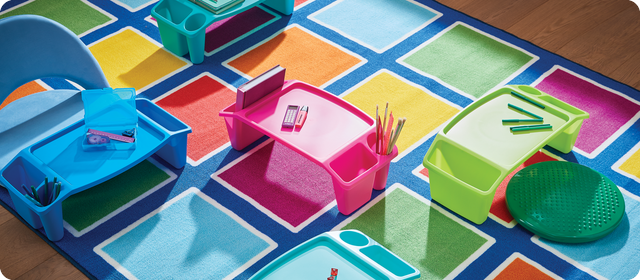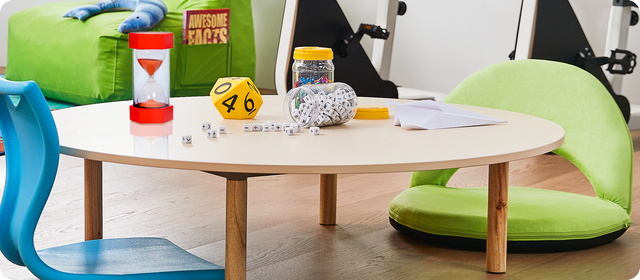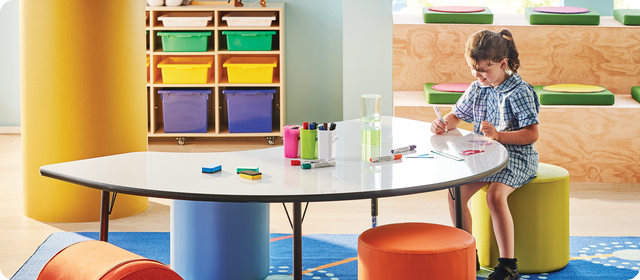Special Education Teaching - More Similarities than Differences
Posted by The Elizabeth Richards Team on
I first met Jacqueline Gorey at the 2014 Special Education Principals & Leaders Association of NSW (SEPLA) conference in Manly. Jacqueline is a Leader of Teaching and Learning at the Mater Dei School in Camden NSW. Mater Dei caters for students from Kindergarten to Year 12 who have been assessed with mild to moderate cognitive disabilities as their primary disability and is a co-educational Catholic Congregational school located in the Wollongong Diocese.

The property that the school is on covers 500 acres of beautiful rolling hills with large gum trees and a tree lined driveway, belonging to the Sisters of the Good Samaritan. The setting is idyllic and the Outdoor Learning & Sensory facility was bathed in sunshine and full of happy children on the day I arrived to speak with Jacqueline. It struck me that I was expecting the learning environment to be completely different from the mainstream schools I had visited, and my presumption could not have been further from the truth. Of course there were the obvious differences with increased security and a higher teacher to student ratio but in regards to obvious differences, that was it. The children were running around playing happily together and testing the boundaries like all students do. I was fortunate enough to speak with Jacqueline whilst also observing a lesson in one of the schools K – 2 classrooms. Jacqueline has been a Special Education Teacher for 20 years; she was inspired to attend university after seeing a little boy in her home town of Chinchilla, Queensland with Autism. Like many other teachers I have spoken with Jacqueline struggles to picture herself doing anything other than teaching, she has occasionally thought about it but always comes back to where she is happiest, in the classroom.
As an executive teacher Jacqueline feels very fortunate that she now has the opportunity to work with both students and staff. In her role as a Leader of Teaching and Learning she spends 2 days on class and the other 3 days in the classroom in a supporting role. The school is striving to establish exactly where each student is placed in their individual learning through assessment and then use these findings to differentiate their approach and best help them continue to progress.
Like all classrooms Jacqueline stressed they have the Bell Curve and need to take the differentiation of each student into account when planning their lessons. Jacqueline made it very clear that Mater Dei is like any other school she has taught in whether it be mainstream or additional needs. “Kindies are all the same, Year 5’s are all the same and the parents are the same. Kids are kids and there are more similarities than differences.” As an observer one of the obvious differences is that the class size is about half the size of a mainstream school. With an average of 11-13 students per class Mater Dei has the ability to really focus on the differentiation of each student and provide a comprehensive, holistic and individual approach. Senior Students are still able to achieve their HSC, although it is entirely based on Life Skills syllabi with no formal, mandatory external examinations. Yet they still have great expectations of their students to maximise their academic and personal achievements. While I was at the school the focus in the classroom was on money lessons and assessing where each student was, a second assessment will be done at the end of the term to see what advancements each students has achieved.
Mater Dei has a great sense of community and inclusion, with 150 students it is easy to know everyone’s name and personalities. Jacqueline says that most of their staff have been at the school for many years and like everyone else they have had to adjust to the new curriculum and how this works with the differentiation of each student. For the most part Jacqueline feels that they did not have to deal with a lot of the issues of mainstream schools. They don’t really have to deal with behavioural issues as such but rather disabilities in which they are specially trained to handle and teach. Jacqueline says she quite often hears that she must be a really patient person to work children with disabilities to which she responds that she couldn’t imagine for example teaching a Year 9 class in a mainstream school. This is the environment she is trained to work in, this is where her passion is and yes she is patient but no more than any other teacher. She stresses that her students still have to reach their KLA’s and she expects them to work to the best of their ability.
At Mater Dei they have worked on many different projects, last year they vertically aligned all their maths classes and different teachers worked with groups on a 2 week rotation. Generally though they are like every other school where their projects are curriculum driven. In terms of effective teaching strategy they implement direct instructions and time delay to keep lessons moving along and help maintain students focus. In some instances the student may benefit from a weighted or pressure vest or blanket to enhance their proprioceptive feedback. It is most commonly used for students with ASD (Autism Spectrum Disorder) as it helps to decrease the student’s response to stimuli and it quite simply it feels good. Mater Dei aims to create a flexible learning environment which can be changed very quickly to cater to the lesson. They keep their resources in very small groupings maintaining order and preventing lost teaching time.
As a teacher Jacqueline says there are many rewarding moments, some may seem very small when looked at on their own but when placed into the context of where a student began they take on a greater significance. While speaking with Jacqueline one of the students separated himself from the group and sat quietly at the table near us throwing coloured pencils one by one onto the ground. He then picked them all up and repeated the process. 12 months ago this young boy struggled to even stay in the classroom and even though he had moved away from the group it was after sitting on the floor and participating for the first part of the lesson. It was also very clear that he was still engaged and listening to what the group were doing he just needed some time out. The teachers recognise this is not a behavioural issue and that this student has made great progress when you look at where he began. Jacqueline recalled an incident when she was teaching in London and worked with a year 5 boy, Joe with ASD who spoke only one word, “Yogurt”. During a music class Jacqueline noticed that he had perfect rhythm and then she asked if he can say yogurt why he can’t say anything else. In addition to this Joe, was not able to cope when in lifts or similar real life situations. On an excursion to an art gallery Joe became very distressed in the lift and it became a great concern to Jacqueline as to how this student would cope with the usual parts of life that he would have to deal with as an adult. Knowing that they needed to get Joe back in the lift to return to school she suggested to Joe that they start to “rock and get into rhythm” prior to getting in the lift. This was some years ago in London and the song of choice was the Spice Girls, Wannabee, (tell me what you want, what you really really want, could be heard throughout the building!) Of course if this was today Joe would have the benefit of ear phones with music offering a calming effect, but this was a breakthrough moment which then led to him being able to explore his world far more widely now he had an approach to use. It even helped with dentist appointments, using public transport and he went from strength to strength. Joe began talking and was able to use his coping skills to avoid the high levels of anxiety which had stopped him from participating in his world.
In terms of how teaching has changed over the years, Jacqueline feels that putting aside the obvious advances and introduction of technology in the classroom, that really kids haven’t changed that much. The goal is still to stay just above the zone of proximal development and provide and present a lesson which adheres to the principles of the Universal Desire for Learning.
Jacqueline feels that the responsibility is on the teacher to find each students strength and a way for them to reveal this. Differentiated assessments and creating an environment where you find the way that is best for each student, not just the way you want them to complete the task. Just because they haven’t done it your way doesn’t mean they can’t do it another way. As a teacher your enthusiasm and ability to sometimes take a risk with a lesson is key to success. You still need to have expectations of all your students regardless of their abilities. Jacqueline aims to support her student’s families and keep raising the bar, to keep moving forward and ensure that she respects her students and gives them the tools to succeed in life, just like every other teacher in every other school.










